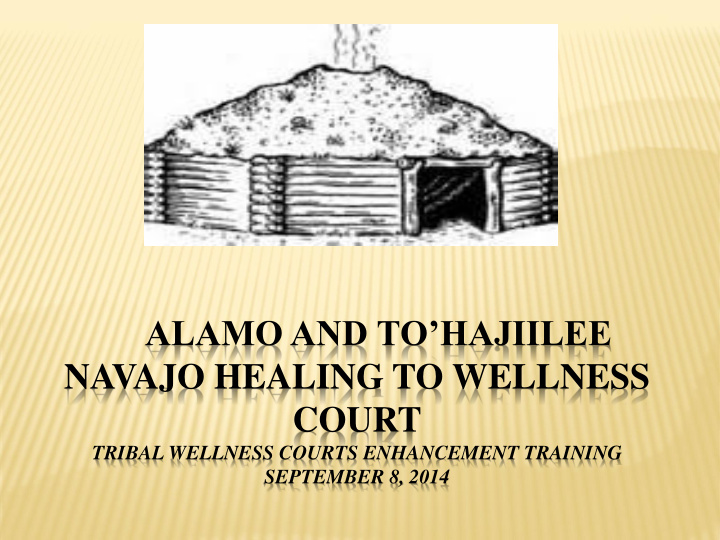



ALAMO AND TO’HAJIILEE NAVAJO HEALING TO WELLNESS COURT TRIBAL WELLNESS COURTS ENHANCEMENT TRAINING SEPTEMBER 8, 2014
ALAMO-TOHAJIILEE JUDICIAL DISTRICT WWW.NAVAJOCOURTS.ORG (NO. 8 ON THE MAP) Satellite Navajo communities (Canoncito Band of Navajos and Alamo Band of Navajos) Bernallillo, Cibola, Socorro AZ NM and Sandoval Counties NAVAJO NATION JUDICIAL DISTRICTS
ALAMO AND TO’HAJIILEE COURT HOUSES
NEW MEXICO DATA- ALCOHOL RELATED DEATH NM has highest alcohol-related death rates in the US for past 30 years American Indians have higher alcohol-related death rates than other race/ethnicities. McKinley and Rio Arriba Counties have extremely high alcohol-related death rates 2008 – 2012: most death rates Bernalillo, San Juan, Santa Fe, Dona Ana and McKinley. Navajo vajo Nation n lo loca cated ed in n McK cKinle nley, , San n Ju Juan, n, Bern rnalill alillo, o, Cibola, ola, Soco corr rro, o, Rio Arr rriba, a, Sand ndoval al N.M. Substance Abuse Epidemiology Profile, Aug. 2014
ALCOHOL RELATED DEATHS NM: 120.1 per 100,000 Tohajiilee: Bernalillo: 109.1 per 100,000 Cibola: 114.1 per 100,000 Alamo Socorro: 226.0 per 100,000 NM Substance Abuse Epidemiology Profile, Aug. 2014
ALCOHOL RELATED CHRONIC DISEASES NM Data: Chronic liver disease associated with chronic heavy drinking American Indians (both Males and Females) are at higher rates than any other ethnicity or race and it further illustrates the heavy burden of premature death due to heavy drinking NM Substance Abuse Epidemiology Profile, Aug. 2014
ALAMO-TOHAJIILEE DISTRICT DATA NM Chronic disease death rate: 67.3 per 100,000 Hispanic 27.3 per 100,000 To’Hajiilee Bernalillo 69.5 Cibola 69.5 Alamo Socorro 144.1 NM Substance Abuse Epidemiology Profile, Aug. 2014
ALCOHOL RELATED INJURY DEATH Binge Drinking, motor vehicle, homicide and suicide Since 1990, NM’s death rate for alcohol related injury has been consistently highest in the nation, 1.4 to 1.8 times the national rate. There were substantially high numbers of death rates among American Indian and Hispanic males. (52.8 AI) (25.8 Hispanic) NM Substance Abuse Epidemiology Profile, Aug. 2014
9/7/2014 ALCOHOL RELATED CRIME Alcohol and drug use play a “significant role” in violent crimes in Indian Country. According to DOJ, American Indian victims reported alcohol use by 62 percent of offenders compared to 42 percent for all races. Indian Country Criminal Justice: Departments of the Interior and Justice Should Strengthen Coordination to Support Tribal Courts, GAO Report, Feb. 2011 9
GENDER THAT ARE AT HIGH RISK American Indian Males are (77%) 2-4 times higher then females (23%) to die of alcohol related injury. (Male-84.2) (Female-24.7) McKinley and San Juan counties show elevated rates of alcohol related injury deaths. New Mexico 52.8 Bernalillo 39.6 Cibola 44.6 Socorro 81.9 NM Substance Abuse Epidemiology Profile, Aug. 2014
NAVAJO GENERAL HEALTH STATISTICS Navajo people are at exceptionally high-risk for alcohol/substance abuse problem; according to IHS, the alcohol related illness and death among tribes was 5.6 times higher than among the U.S. population. The report terms the rate of death from alcoholism among the Navajo “the most alarming” statistics -26.6 per 100,000 on the Navajo Reservation. In the U.S. as a whole the rate is 2.1 per 100,000. Motor vehicle accidents comprise the second leading cause of death on the Navajo Nation at 6.8% as compared to the U.S. rate of 1.9% (over 3 times higher). www.nihb.org
I.H.S. FUNDING INEQUALITIES Per capita funding for NA health care (through the IHS) is 60% less than is spent per capita on health care for NAs than it does on Medicaid recipients, prisoners, veterans or military personnel. As a result, the IHS has a severe problem in recruiting and retaining mental health professionals. The IHS systems are severely underfunded: for NA youth, only $30 per year per person is spent on behavioral health for one NA, including hospitalization. MacArthur Foundation Mental Health Policy Research Network, 2008 MacArthur, Project TRUST, p. 46,http://hsc.unm.edu/som/prc/_pdfs/TRUST_Report_May08.pdf 12
“ T’ÁÁHW7 ÁJ7T98GO YÁ’ÁT’ÉÉH “BY YOUR CHARACTER AND IDENTITY, N7ZHDOODLEE[” YOU WILL BE HEALED AND BE WELL” Judicial Branch Peacemaking Navajo Nation Program Prayer Lodge NAVAJO HEALING TO WELLNESS COURT
INTERAGENCY COLLABORATION Two 638 Tribal Behavioral Health Programs (Navajo Area and Albuquerque Area) Navajo Prosecutors office Peacemaking Program (Peacemakers doing the education with the Participants) Navajo DBHS – Traditional healing and teachings (prayer lodge)
FUNDAMENTAL LAW Restorative Justice – Beauty way concept Diné Bi Beenahaz'áanii (1 N.N.C. §§ 201-206)- Codified (written into the law at Title 1, see www.navajocourts.org) (Traditional Law; Customary Law; Natural Law; Common Law) Spiritual healings and respect for spiritual beliefs
COMMUNITY ENGAGEMENT Steering Committee Vision Statement Resource Mapping Needs Assessment Action Planning – Community Activities Some members are youth or young adults Elders Resource Meetings (Community Coalition) Local Behavioral Health Collaboratives (NM) NM State Native American Subcommittee of the Governor’s Behavioral Health Planning Council (Inter Tribal Coalition)
EVALUATION Process evaluation: Program Participants Resources Steering Committee Gather lessons learned and other qualitative data Navajo Human Research Board (IRB)
QUESTIONS Do you have any questions? Ahee’hee’ Thank You.
FOR MORE INFORMATION Contact: www.navajocourts.org Jamie S. Mike, Care Coordinator thtwc14@gmail.com (505) 908-2817/2818 Regina Begay Roanhorse, Court Administrator reginaroanhorse@navajo- nsn.gov (505) 908- 2817/2818
Recommend
More recommend